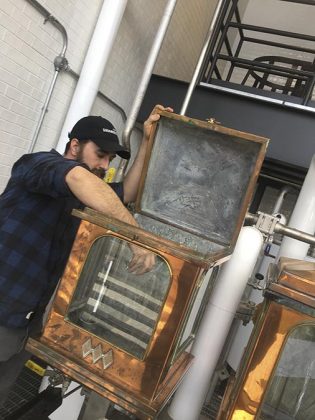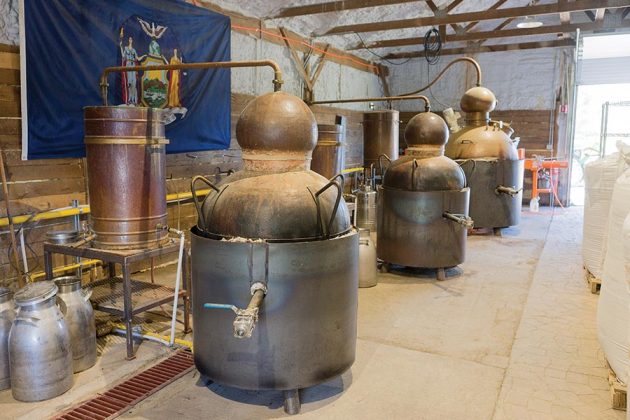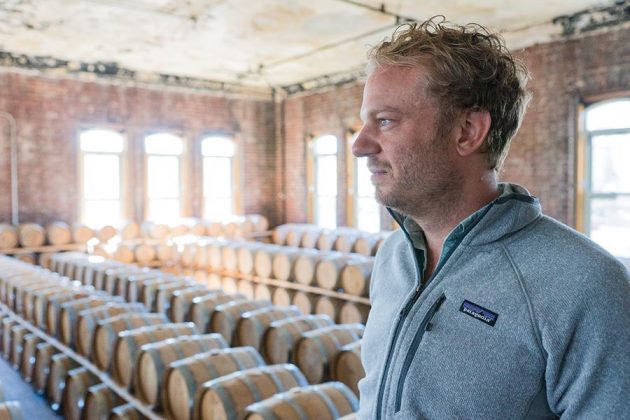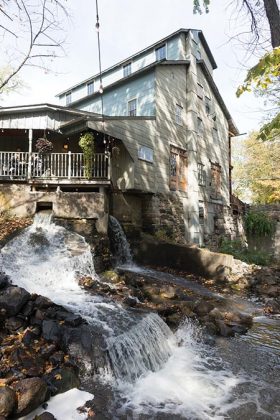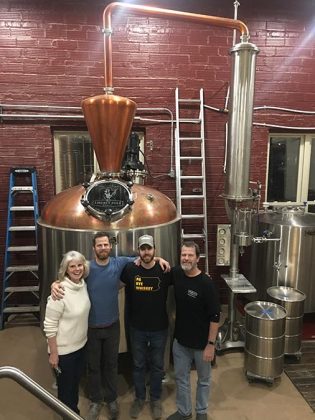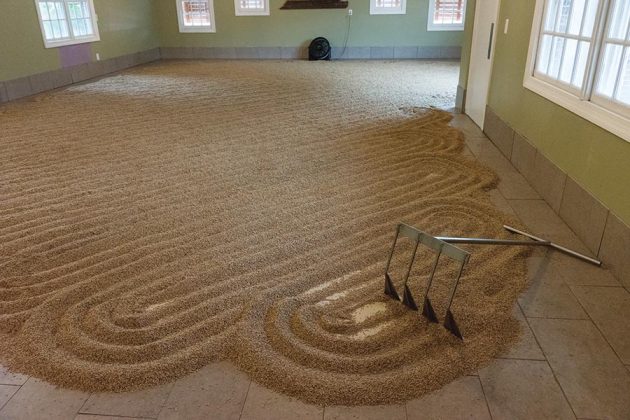From the end of Prohibition in 1933, rye whiskies were in steady decline, with 150,000 cases of sold in the United States compared with 14.7 million cases of bourbon in 2006. It was the reemergence of cocktail culture in major US cities during the dawn of the new millennium that spurred the volume growth of rye whiskey 20% then and 30% in 2007, with 2019 finding distilleries generating $236 million of sales from 1.21 million cases of rye sold. Presaging this in 2001 was the development of Mount Vernon Distillery, a project initiated with the support of DISCUS.
The birth of whiskies in North America was predominantly predicated upon the use of this northern European grain in the areas which became Maryland, New York, Pennsylvania and Virginia. While the recent resurgence of rye is by no means limited to the northeast, this dive into its heartland explores the efforts, challenges and successes modern artisans enjoy.
MARYLAND
Downtown Frederick is home to two notable rye producers that opened in 2016. McClintock Distilling, the state’s only certified organic distillery, is a partnership between college buddies Tyler Hegamyer and Braeden Bumpers, and which operates out of a gutted 5,000 sq. ft. classic Buick auto garage. “Working with pre-Prohibition, non-GMO grains allows us to distinguish ourselves from our competitors,” says Hegamyer. However, it’s a narrow supply band. “It ties our hands,” he admits, “as most small farmers gearing up for high-quality grains are mostly growing for bakeries; husks remaining from blowing grains aren’t usable for our needs.”
A three-minute walk away is Tenth Ward, its distiller Mark Vierthaler double-pot distilling with a 600-gallon system. He sources grains from a single contract farm in West Virginia which malts on site, though sourcing from a single farm creates quality and quantity issues. “We’re looking into working with him to source more heritage ryes,” says Vierthaler. “As he expands we hope to develop older strains and other grains.”
A few miles east is Mount Airy’s MISCellaneous, its owner Dan McNeil boldly announcing to “Live and Drink by Your Own Rules” and telling me his story in doing so. “I’d been homebrewing a few years but really wanted to make rye whiskey from locally sourced grains, and an old friend who’d just bought nearby Gravel Springs Farm agreed to plant corn and rye at my behest.” McNeil trucks the grains to a Virginia mill for his 100% unmalted rye mash bill, stone grinding back in Mount Airy “so the grain doesn’t heat up much, keeping more of the flavors intact than were we to have used a roller or hammer mill.”
Alongside its wines and beers, Springfield Manor’s St. Angelo family sells rye only from their tasting room, which the patriarch, John, says “helps us to leave it in barrel for three years.” Best known for their annual sell-out June lavender festival, John explains, “we grow our corn, a big contributor to our rye’s mash bill.” Backing up to Cunningham Falls, the farm has numerous artesian springs yielding naturally filtered low-iron, limestone spring water.
Launched by Under Armour CEO Kevin Plank April 2017 to take Maryland rye to the world, Sagamore Spirit’s employee #1 was Rachel Fontana. Now with 80 colleagues “dedicated to inspiring interest for Maryland rye, and to develop a true investment into Baltimore,” she confirmed what my research had borne out, that “there really isn’t an historic published Maryland mash bill to refer to,” with the style dependent upon the limestone water of the state’s western springs.
Max Lents, Eli Breitburg-Smith and Ian Newton partnered when there was little distilling in the state. With Breitburg-Smith brewing professionally, “we worked in a vacuum, and didn’t build a prototypical craft distillery,” says then-bartender Lents. “When I moved to Baltimore in 2008 people were commonly drinking Pikesville white label rye.” Though it was made elsewhere, they realized Baltimore was the heart of rye consumption and traditional production, so they set about opening a small distillery in 2015 a mile south of their current Union Collective Project site. “We knew rye would be the focus of our work,” he says, despite the quick expansion of their portfolio necessitating the moniker Baltimore Spirits Company.
NEW YORK
Unique amongst US states is Empire Rye, a voluntary initiative launched in 2015 by New York distilleries, establishing an identifiable state rye whiskey style with standards reflecting the state’s Class D license in that a minimum 75% of its mash bill contain rye grown within New York, be distilled to no more than 160 proof, and its entirety manufactured at a single New York distillery. Touched upon here are most of Empire Rye’s nine active members while its website lists 17 more as “committed.”
Along the eastern shore of Seneca Lake, Brian McKenzie presaged an economic downturn in evaluating business opportunities. That, and a personal love of distilling fueled by his Scottish heritage, inspired him to align himself with whiskeys and the burgeoning wine tourism in the Finger Lakes. “In collaboration with other early craft distillers, we created the foundation for what became the Farm Distilling License, legislation passed in 2007 allowing us to begin distilling in 2008,” he says, with his 2012 first release a namesake rye. “We saw a lot of ryes made with a lot of corn and some big rye whiskeys coming from Canada,” leading him to decide upon a mashing of 80% Danko rye sourced as near as 300 yards away from the distillery.
“Empire Rye is as unique and definable as Kentucky bourbon or Tennessee whiskey,” proudly says Jason Barrett of Black Button. “I wanted to ensure we found a balance between an historically accurate and commercially practical style.” Barrett’s “urban farm” operation works with a 96% rye, 4% malted barley sourced, as with all grains, from nearby 1,600-acre Edgewood Farms, mashing in a double pot still “just like it would have been in Rochester 150 years ago.”
Matt Jager was working with a small distillery when approached in 2014 by his current partner in creating their Yankee brand. Then unmarried and childless, he barreled whiskey without selling it, later struggling with customers who “would turn their noses up at ryes, telling me that ‘these are what my grandparents would drink.’ Now I sell as much of my rye as bourbon.” Yankee’s Empire straight is 76% Aroostook rye with a blend of malted and unmalted winter wheats.
Growing rye on-site enabled Tuthilltown Distillery’s Brendan O’Rourke to learn which grains to distill before creating mash bills, spurring him to keep solids through the first distillation in Carl double pot stills for its Hudson Manhattan. “Rye doesn’t mill easily; it’s very sensitive to temperature when mashing, it loves to foam while fermenting and it never ferments fully dry so the residual sugars make the first distillation much more difficult.”
Kentuckian Colin Spoelman loved bourbon and, as Brooklyn’s Kings County owner, didn’t quite understand the interest in rye as its bill yields 60% of that from a bourbon and “the sticky mash makes it difficult, requiring many distilling sessions and more time cleaning. But when our first head blender returned from a conference wanting to make an Empire rye, I was initially hesitant, eventually deciding to make 20 barrels. The first two-year-old releases from the founding Empire Rye producers gave us all confidence to commit to the concept, and since it’s gained traction since ‘craft’ and ‘small batch’ are too vague to be meaningful.”
Daric Schlesselman came to rye through Coppersea’s Christopher Williams, who’d proposed to him what became the Empire model. Initially skeptical while focusing upon a four-grain whiskey at his Van Brunt Stillhouse, Schlesselman selected Danko from a single farmer with the remaining 25% malted barley. When the Empire consortium was conceived, his rye formulation fit the criteria it’d set and so he joined. “The guidelines are really basic for making good whiskey and not taking shortcuts.”
PENNSYLVANIA
Before the enshrinement of free speech expressions in US law, distiller Philip Wigle was arrested for sedition, having erected a Liberty Pole proffering “No Excise Tax.” Western Pennsylvania’s two whiskey distilleries derive their names from this tale.
“When my husband Alex and I started, we didn’t pursue a model that companies like Diageo would always win,” says Wigle co-founder Meredith Grelli. They chose to embrace diversity in a boring whiskey landscape, bringing “regality to rye’s heritage through transparent education, and by controlling our distribution channels,” as Pennsylvania’s only whiskey-focused distillery at their 2011 opening.
Former computer software developer Jim Hough with wife Ellen, sons Rob and Kevin staff Liberty Pole, a key historic term for their downtown Washington site; every July the town hosts a whiskey festival featuring the tarring and feathering of a whiskey tax collector. Jim, a backyard distiller, approached Bill Owens for advice on going pro, and Owens told him that being in the traditional heartland of Pennsylvania whiskey distillation that he needed to make whiskey. Four months after opening in 2016, their mechanical engineer sons asked to join the new family business. “Consumers are much more sophisticated now,” says Ellen of their numerous customers coming from far away seeking collectible indigenous ryes. “We’ve many Pittsburgh chefs who like our whiskeys,” helping to spread word of their existence.
As at Wigle, they’re transitioning from 25 to 53 gallons though “the cuts will widen when moving to larger barrels,” reflects Kevin. “Cutting our teeth on smaller barrels helped us to work with the grains, water, still on a very intimate level.”
Andrew Martin was captivated by distilling in his reading of it. “With beer you only cook it and ferment in what’s a simple process, but the process and equipment needed for spirits meant you couldn’t just do it at home, a challenge that caught my imagination,” he says. So, he learned how to build a 150-gallon still in his basement and garage while seeking a Lancaster business location — all of which were ready for his 2013 opening. “I wanted to make rye whiskey because I like it,” he says, “and that it’s uncommon and historic to the region.”
Piqued by the 2012 law, David Stein transitioned from a successful retail petroleum designer/contractor of 35 years to distilling in 2015. He attended Kentucky’s MB Rolland distilling class, opened Hidden Still in Lebanon with son-in-law Coty Edwards as lead distiller. Since then he bought an abandoned cigar factory in Hershey for what’ll soon be moved to a 30,000 sq. ft. distillery and restaurant focusing upon pot-stilled straights, with the expectation that by the end of 2020, all will be 4 years old. “If I concentrate on failing I’m going to fail; I haven’t time to think of it nor to fail,” he smiled.
Stoll & Wolfe (see article in Distiller Winter 2019/2020) co-owner Avianna Wolfe sees “the success of craft rye distillers is predicated upon providing timely and accurate information; tell people that the Jim Beam they buy isn’t necessarily made with anything near Bardstown except the water!” Her focus is upon developing total infrastructural growth. “The distiller ought to have greater access to locally grown grain,” she insists, though she’s aware that farmers must also be willing to grow, harvest, clean and — most importantly — store the rye.
After a stint as Victory Brewing’s packaging manager, mechanical engineer Jared Atkins drove to Virginia’s Catoctin Creek and was hooked upon distilling. “It had a broader horizon than beer — I wanted to be part of something in its infancy,” he says. He made the jump in 2015 when he opened Bluebird at its Phoenixville location. White rye is one of his flagship products, done before he released a corn white, but he says, “now that we’ve an aged rye the white’s taken a back seat. Consumers at first didn’t know what white rye was.” He chose to go 100% rye, 80 raw and 20 malted, for a spice-forward palate with a fruity finish.
Chemical engineer Herman Mihalich grew up in his family’s steel mill town tavern along the Monongahela River, a mile away from a distillery which had its rye served at the bar. Begun during Prohibition, the tavern and the steel mill closed in the 1970s. In 2009 Mihalich wrote a business plan and acquired investment capital from school friends. He launched Dad’s Hat in 2011, based upon a recipe of 80% rye, 15% malted barley (2-row brewer’s) and 5% malted rye in order to encourage starch conversion. “Using that much malt gives fruitiness balancing the primary spicy and grassy characters of rye,” Mihalich says. He sources rye from Bucks County’s Nevada Mease, who’s patient in leaving his rye in the fields until mid-July providing a very ripe berry.
Before developing an interest in distilling, Rob Cassell worked at Harpoon and Victory breweries. After a short course at Michigan State University, he set off to Scotland for training before writing the business plan for Philadelphia Distilling. “It was initially hard to raise capital because then there were no microdistilleries in Pennsylvania for investors or bankers to review,” he recalls; but he grabbed the state’s first microdistillery license in 2005. The following year he lobbied the legislature to create new licensing procedures allowing him to sell at his site, and in 2012 a law allowing this was established, a watershed law for the entire US craft distilling industry. At the time New Liberty was one of three distilleries, now Pennsylvania hosts 138, with the bill he created a template for comparable bills throughout the US.
VIRGINIA
In 2015, engineering contractors Bill Karlson and John O’Mara established their aptly titled KO distillery and have recently launched an equipment upgrade of a 30-foot continuous column still, tripling production to more than 800 barrels annually. Their Bare Knuckle line of whiskeys features three straight ryes sourced from 100% Virginia rye to be double-distilled and aged in Kentucky-made barrels; its 90 proof standard is aged 17–18 months, with a single barrel version aged at least two years and a 118–125 proof cask strength aged at least two years.
Arguably Virginia’s best-known operator is Catoctin Creek which opened 2009 in the country’s wealthiest county, Loudoun. Its range of Roundstone Ryes constituted of a 100% rye mash are aged in Minnesota white oak casks for just under two years and bottled at proofs of 80, 92 and a cask at approximately 116. In 2013 owners Scott and Becky Harris installed a solar array, offsetting 85% of its distillery’s electrical usage and which on sunny days generates enough energy to return some to the public grid.
Copper Fox’s master distiller and co-owner Rick Wasmund’s childhood fascination for wood and fire expresses itself through the choices made for malts he smokes with apple, cherry, peach and sassafras woods in the malt floor and kiln he built with his sister Cheryl — the first distillery in North America post-Prohibition to do so. Rick interned at Bowmore to study the floor malting of barley, and the siblings now endeavor to source grains locally via partnerships with local farmers, its 2- and 6-row barleys developed at Virginia Tech and grown on the fields of Virginia’s Northern Neck.
Founded a few blocks from Capitol Hill, Filibuster Distillery’s since relocated to a former apple production plant in Shenandoah Valley in order to accommodate a new continuous still. Its dual cask rye, blended with barley, is aged four years in #4 char 53-gallon barrels and finished in a dizzying array of California and sherry wine barrels.




